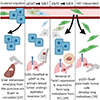EMT, MET, Plasticity, and Tumor Metastasis
- PMID: 32800658
- PMCID: PMC7647095
- DOI: 10.1016/j.tcb.2020.07.003
EMT, MET, Plasticity, and Tumor Metastasis
Abstract
Cancer cell identity and plasticity are required in transition states, such as epithelial-mesenchymal transition (EMT) and mesenchymal-epithelial transition (MET), in primary tumor initiation, progression, and metastasis. The functional roles of EMT, MET, and the partial state (referred to as pEMT) may vary based on the type of tumor, the state of dissemination, and the degree of metastatic colonization. Herein, we review EMT, MET, pEMT, and plasticity in the context of tumor metastasis.
Keywords: EMT; MET; cellular plasticity; colonization; metastasis; pEMT.
Copyright © 2020 Elsevier Ltd. All rights reserved.
Figures


References
-
- Polyak K and Weinberg RA (2009) Transitions between epithelial and mesenchymal states: Acquisition of malignant and stem cell traits. Nature Reviews Cancer, 9, 265–273 - PubMed
-
- Dongre A and Weinberg RA (2019) New insights into the mechanisms of epithelial–mesenchymal transition and implications for cancer. Nat. Rev. Mol. Cell Biol. 20, 69–84 - PubMed
-
- Pastushenko I and Blanpain C (2019) EMT Transition States during Tumor Progression and Metastasis. Trends in Cell Biology, 29, 212–226 - PubMed
Publication types
MeSH terms
Grants and funding
LinkOut - more resources
Full Text Sources
Medical
Research Materials
Miscellaneous

